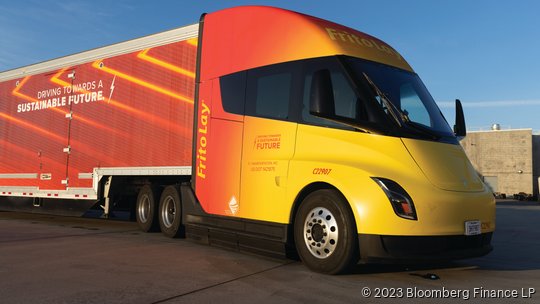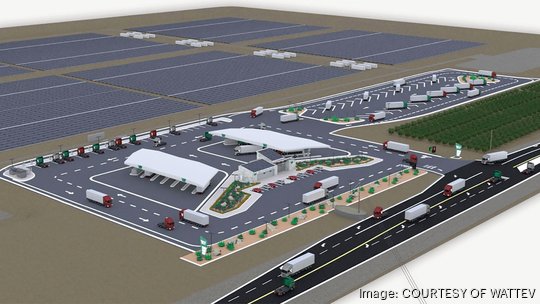California mandates are pushing companies and fleets toward an aggressive conversion of heavy trucks to zero-pollution vehicles, but it’s a path with plenty of obstacles, and possibly not enough electricity where it will be needed.
The state is making the push to quickly get more electric vehicles on the road to combat the problems of air pollution and climate change.
The mandates, some starting next year, don’t address the physical problem that the electricity isn’t near where it needs to be used by fleets to charge new electric trucks. Building electrical infrastructure is costly and time consuming.
Another problem is that while the heavy trucks that are going to be part of future electric fleets are in development, they aren’t actually available in numbers on the market yet.
It is one thing to mandate EV heavy trucks, but it is another thing entirely to make the mandate actually work on the streets.
Some fleets will need megawatts of electricity to charge their trucks, and that could be in places where that level of power currently doesn’t exist, said Gary Simon, chairman of CleanStart, a nonprofit that connects and supports clean technology companies in Northern California.
Truck depots, logistics warehouses and distribution centers tend to be out in the fringes, not necessarily near where robust electrical connections and substations are sited now, he said.
High-power electric transmission lines and electrical substations are expensive investments that take years to permit and build.
“California has been the leader in pushing technology and regulation, but this is going to be a real challenge,” Simon said.
The Sacramento Municipal Utility District recently completed two new substations, one that cost $45 million, and a high-tech Downtown station that cost $94 million and took seven years.
A fleet-charging depot, which previously may have been just a small commercial electric customer, with the installation of multiple heavy duty truck chargers could suddenly become a user of megawatts of energy, said Chris Shimoda, senior vice president of government affairs with the California Trucking Association.
“The issue of the infrastructure able to actually support the transition to electric trucks is only being considered after the rules were adopted,” he said.
For example, a company with 40 heavy trucks using mid-range 250-kilowatt fast chargers could draw 10 megawatts of power to a depot location that previously just needed enough electricity for the lights, a refrigerator and air conditioning. A megawatt is enough to power more than 750 homes.
“That is like adding several subdivisions in a single location. That is factory-level demand popping up in rural and urban locations all over the state,” Shimoda said. There are companies with 40 or more trucks all over urban areas like Los Angeles, the Bay Area and Sacramento, and they are spread through logistics hubs in more rural areas like West Sacramento and Woodland.

Adding EV truck chargers all over California will add burden in a state that sometimes already has problems delivering electricity during times of peak load, Shimoda said.
“We know infrastructure is a big challenge,” said Paul Arneja, who works in the Mobile Source Control division of the California Air Resources Board, or CARB. Fleets will have time to prepare, he said.
In April this year, CARB approved its Advanced Clean Fleets rule, which starts a phased transition to zero-emissions technology for all trucks and busses on California roads by 2045. That includes a mandated conversion to zero-emission heavy trucks that starts next year for fleets of more than 50 vehicles, and eventually gets to no new sales of petroleum-powered heavy vehicles by 2036.
The people at CARB know that the infrastructure is lagging, Arneja said. “The regulation has exemptions and extensions.”
To scope the challenges, the state is putting together an “Integrated Energy Policy Report” to accelerate deployment and connection of clean energy resources to the grid. That report will highlight what the California Energy Commission, the California Public Utilities Commission and the California Independent System Operator are doing to address issues and make recommendations.
A draft report is expected to come out this fall.
Estimates of what the electrical load of electric transportation will look like in a decade are pretty wide. The California Energy Commission projects that load from an estimated 8 million EVs in 2030 may range from 1,000 megawatts to 5,500 megawatts depending on the time of day, said Anne Gonzales, spokeswoman for the Folsom-based California Independent System Operator, which manages and balances most electric load within the state and with many Western grids.
“The impact of the state mandates is not yet fully known, however EV growth and EV load characteristics, along with all distributed energy resources, are areas we are working to better understand as the adoption of transportation electrification continues to increase under state policies and consumer EV adoption," she said.
The amount of electric load itself isn’t as much a concern as the impact of when all this charging occurs “and the impact to the overall load shape,” she said.
The problem is math
Level 2 EV car chargers for the home are rated around 14 kilowatts and they take about seven hours to charge. Heavy-duty trucks tend to use 150 kW to 350 kW chargers to charge in 30 minutes to a couple hours, longer for long-range applications over 200 miles.
The bigger and heavier the truck, the longer it takes to charge them. That is a problem that theoretically can be solved by faster charging speeds, but faster charging speeds create their own problems on the utility grid.
“Every problem that gets solved by faster charging creates a new problem in infrastructure. We don’t have all the infrastructure to do this,” Shimoda said. Transmission lines and substations take years to develop, and they can be controversial developments.
The end users, which are truck depots and fleet operators, are not necessarily at places where the grid can supply them with megawatts of electricity.
SMUD is adding 3,000 megawatts of new generation and battery storage in its quest to get to zero-carbon by 2030. As part of that goal, announced in 2020, SMUD added 370 megawatts of new generation in the past two years and it has 1,500 megawatts of new generation, mostly solar photovoltaic, in various stages of development.
SMUD estimates it will have 288,000 electric passenger vehicles in its territory by 2030, and about 27,000 medium and heavy-duty trucks, said Evan Speer, transportation electrification strategist with SMUD.
“The good news is that through 2030, our grid has the capacity to meet demand,” Speer said. After 2030 and through 2040, however, the grid will need serious upgrades.

Also, beyond capacity, SMUD will need to work on how it gets power out to customers like truck depots. It's an issue that will face utilities across the state.
The effort to electrify transportation will require coordinated planning and coordination, Speer said. It will also mean that companies using trucks will have to tailor their transportation schedules around charging and availability, something they don’t currently do.
There are times when there is extra power on the grid, but there are many times when power supplies are limited, and then electricity costs more, such as afternoons during the summer. One way around that is to pair charging with massive battery backup, which can take load off the grid during times of abundance to eventually charge trucks during peak times from storage batteries. That also means that not only will truck depots need to install fast chargers, but they would also have to install battery storage systems.
Proponents of the EV truck mandate often argue that fleet operators will save money over time because the estimated operational cost of electric transportation is cheaper than petroleum.
Those estimates, however, are not holding up, said Thomas Hall, executive director of CleanStart. Hall is a supporter of electric transportation, but he says some of the assumptions are far too rosy compared to the current market.
The older state estimates on the cost of electric power for transportation assume a gas-equivalent cost of 90 cents per gallon, Hall said.
Those assumptions on the cost of EV operations are based on low-demand-period electricity prices of about 12 cents per kilowatt-hour. That’s great if you can choose to smart charge when utility prices are low, but that doesn’t consider peak time costs or the cost of public commercial chargers.
Commercial fast chargers can cost around 60 cents per kilowatt-hour, which brings the cost of fuel closer to gas and diesel prices, Hall said. Those estimates also don’t consider the cost of installing chargers, which were assumed to cost about $15,000 installed. The current cost is double that, Hall said.
The cost of electricity will likely have to go up to help utilities cover the cost of building all the new generation, substations, storage and transmission, Simon said. That could make the EV mandates a political football in state and national politics as a pocketbook issue more than it already is.
In September 2020, the state mandated that 100% of all new passenger cars and trucks sold in the state be zero emission by 2035. It got less attention at the time, but that same executive order also set a zero-emission goal for 100% of medium- and heavy-duty vehicles in the state by 2045 and for drayage trucks, used at seaports, and for off-road vehicles and equipment by 2035.
The move to new zero-emission vehicles of all kinds is part of California's statewide goal, set in 2017, to achieve carbon neutrality by no later than 2045.
Then in April this year, CARB set an end date to the sale of new heavy-duty diesel trucks in the state by 2036, as part of an Advanced Clean Fleets rule. The heavy duty truck requirement, which is the first of its kind anywhere, also requires a phase-in of zero-emissions technology for fleet operators starting next year.
It continues to seek an end to the use of diesel and gas in trucks statewide by 2045. That is not an end to sales of those trucks, but the outright end of use of them nearly everywhere in the state. Observers anticipate there will be exemptions.
Starting next year, the state is mandating that operators with more than 50 heavy trucks must start adding ZEVs when they replace trucks. Large trucks operating in seaports and rail yards also must start adding zero emissions vehicles next year, no matter how large their fleets are. Those rules are meant to clean up emissions around areas with high pollution, often near low-income neighborhoods.

The market has begun to respond to the anticipated demand for electric truck charging. WattEV of Long Beach is planning to build the nation's largest truck charging station near Sacramento International Airport in a project expected to be complete by the end of 2025.
WattEV has already built a truck charging station at the Port of Long Beach and is building three others in Bakersfield, Gardena and San Bernardino.
Some light in the tunnel
“Fleets will come to us and say they are going to need 10 megawatts to charge their fleet,” Speer said. SMUD puts them through an E-Fuel advisory program that looks at duty cycles, charge cycles and staggered charging schedules.
With management and coordination, a fleet depot’s estimated need for 10 megawatts turns to 5 megawatts, and with more refining that can turn to 2 megawatts, Speer said.
That kind of scheduling will make for operational challenges that don’t currently exist, with fleets of trucks now able to fill up with diesel at any time. Some of the big trucks need a five-hour charge to be operational.
Outside of city and corporate fleets, many trucks are independently owned and operated. They don’t have a depot to charge at. Public charging places that they will rely on may be more difficult to manage, Shimoda said.
And then there is the issue of the actual electric trucks.
All the major manufacturers of trucks are planning to deliver electric vehicles in the future. The immediate availability is more problematic, said Hall.
“The manufacturers have lots of orders, and that’s great, but they are not delivering in numbers yet,” he said.
Amazon (Nasdaq: AMZN) earlier this year announced that it had rolled out over 3,000 electric delivery vehicles nationwide as part of its commitment to bring 100,000 electric delivery vehicles to the road by 2030, according to Ceres, a Boston-based nonprofit focused on electrification.
Amazon declined to discuss its electric fleet or charging strategies.
Ceres has 31 member companies in its Ceres Corporate Electric Vehicle Alliance, including Amazon. Ceres’ alliance represents companies with more than $1.2 trillion in annual revenue and that collectively own, lease or operate more than 2.7 million fleet vehicles in the U.S.
The truck mandate will be coming into effect as the state also mandates retrofits of offices and apartment complexes to be converted to electrification for heating, hot water and cooking.
“This is more than just a bump in the road. It is a major roadblock,” Shimoda said. “It’s going to be a real struggle.”



